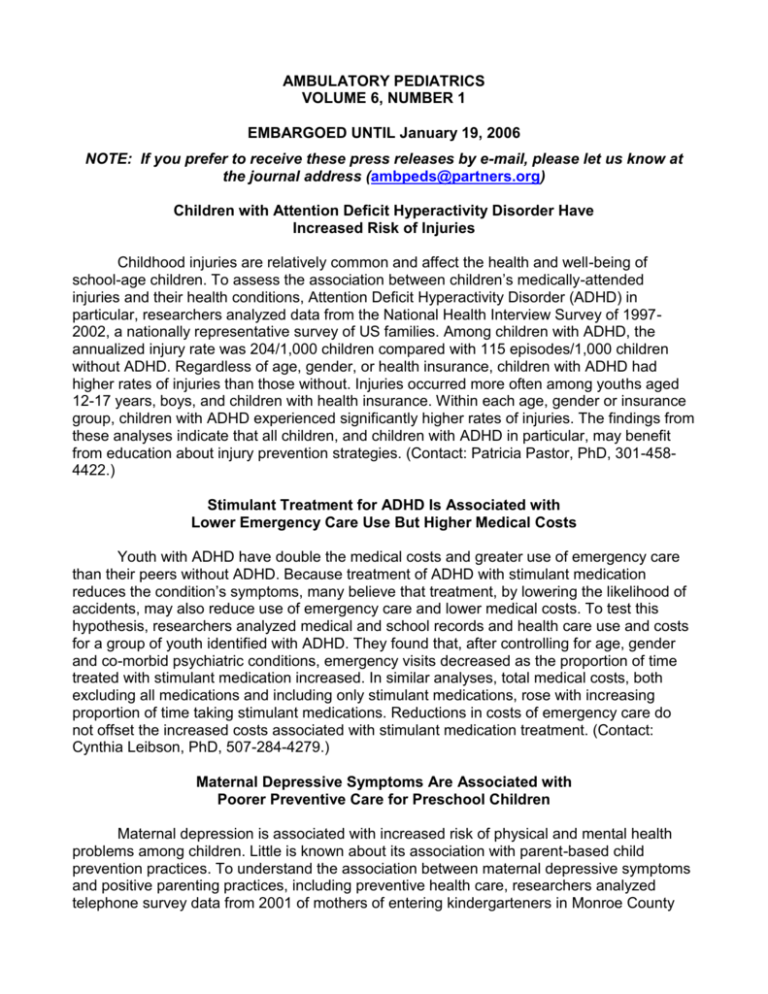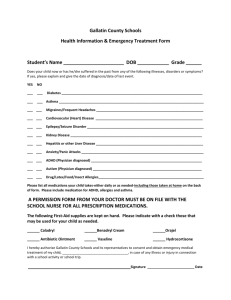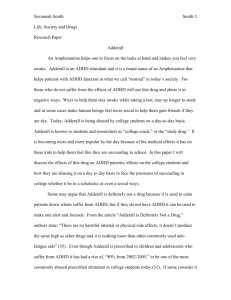Children of Mexican Farm Workers Receive
advertisement

AMBULATORY PEDIATRICS VOLUME 6, NUMBER 1 EMBARGOED UNTIL January 19, 2006 NOTE: If you prefer to receive these press releases by e-mail, please let us know at the journal address (ambpeds@partners.org) Children with Attention Deficit Hyperactivity Disorder Have Increased Risk of Injuries Childhood injuries are relatively common and affect the health and well-being of school-age children. To assess the association between children’s medically-attended injuries and their health conditions, Attention Deficit Hyperactivity Disorder (ADHD) in particular, researchers analyzed data from the National Health Interview Survey of 19972002, a nationally representative survey of US families. Among children with ADHD, the annualized injury rate was 204/1,000 children compared with 115 episodes/1,000 children without ADHD. Regardless of age, gender, or health insurance, children with ADHD had higher rates of injuries than those without. Injuries occurred more often among youths aged 12-17 years, boys, and children with health insurance. Within each age, gender or insurance group, children with ADHD experienced significantly higher rates of injuries. The findings from these analyses indicate that all children, and children with ADHD in particular, may benefit from education about injury prevention strategies. (Contact: Patricia Pastor, PhD, 301-4584422.) Stimulant Treatment for ADHD Is Associated with Lower Emergency Care Use But Higher Medical Costs Youth with ADHD have double the medical costs and greater use of emergency care than their peers without ADHD. Because treatment of ADHD with stimulant medication reduces the condition’s symptoms, many believe that treatment, by lowering the likelihood of accidents, may also reduce use of emergency care and lower medical costs. To test this hypothesis, researchers analyzed medical and school records and health care use and costs for a group of youth identified with ADHD. They found that, after controlling for age, gender and co-morbid psychiatric conditions, emergency visits decreased as the proportion of time treated with stimulant medication increased. In similar analyses, total medical costs, both excluding all medications and including only stimulant medications, rose with increasing proportion of time taking stimulant medications. Reductions in costs of emergency care do not offset the increased costs associated with stimulant medication treatment. (Contact: Cynthia Leibson, PhD, 507-284-4279.) Maternal Depressive Symptoms Are Associated with Poorer Preventive Care for Preschool Children Maternal depression is associated with increased risk of physical and mental health problems among children. Little is known about its association with parent-based child prevention practices. To understand the association between maternal depressive symptoms and positive parenting practices, including preventive health care, researchers analyzed telephone survey data from 2001 of mothers of entering kindergarteners in Monroe County (Rochester), New York. Depressive symptoms were more common among mothers with lower education, lower income, and those living in single-parent households. Mothers with depressive symptoms, compared to those without, were significantly more likely to report their children had no routine dental care in the past year (21.1% vs 8.2% p=.001), brushed their teeth less than two time per day (37.1% vs 25.2%, p=.041), and were read to less than three times per week (31.0% vs 13.7%, p<.001). They also reported higher rates of inconsistent discipline (36.6% vs 20.1%, p=.005) and lower parenting confidence (39.4% vs 18.5%, p<.001). All these associations remained significant in analyses controlling for maternal race, ethnicity, age, education, income and household structure. Child health professionals should recognize how depressive symptoms in mothers affect children’s use of preventive care. (Contact: Megan Kavanaugh, BS, 562-237-3352.) Children with Asthma in Medicaid Managed Care Are Missing Influenza Vaccinations National guidelines recommend influenza vaccination among children with asthma, but nationally, only 10-30% of children with asthma are vaccinated. A telephone survey of parents of Medicaid-enrolled children served in three mature, capitated, managed care plans across the United States was conducted in 1999 and one year later to determine factors association with the uptake of influenza vaccination. In this population, 16% of children with asthma received the influenza vaccination. Children with persistent asthma (OR 0.53, 95% CI 0.36- 0.79) and those who had been hospitalized during the follow-up year (OR 0.29, 95% CI 0.11-0.76) were more likely to be vaccinated for influenza. Children older than 9 years of age (OR 1.66, 95% CI 1.13-2.46) and children of parents with less than a high school education (OR 2.29, 95% CI 1.05-5.03), compared to a college degree, were at risk for missing vaccination. Among children with persistent asthma, older children (OR 1.65, 95% CI 1.012.69) and children of parents with less than a high school education (OR 4.13, 95% CI 1.4311.90) were more likely to miss influenza vaccination. These findings suggest that strategies targeted to parents of older children and families with lower educational achievement may help improve influenza vaccination rates among children with asthma. (Contact: Sangeeth K. Gnanasekaran, MD, MPH, 617-566-8536.) The official journal of the Ambulatory Pediatric Association (APA), Ambulatory Pediatrics provides a muchneeded forum for cutting-edge work in general pediatrics. The journal focuses on areas including child health services research, emergency medicine, research methodology, complementary and alternative medicine, child health policy, and adolescent medicine. Ambulatory Pediatrics is indexed in Index Medicus. ABSTRACTS FOR ALL MANUSCRIPTS WILL BE AVAILABLE FOR REVIEW ON THE JOURNAL WEBSITE, http://www.sciencedirect.com/science/journal/15301567, AFTER THE EMBARGO. JOURNALISTS CAN OBTAIN PREPRINTS FROM THE JOURNAL OFFICE (ambpeds@partners.org).







